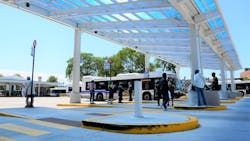Collaborative to aid CTA with predictive occupancy information
A pilot project on the Chicago Transit Authority’s (CTA) 79th Street bus line is looking to answer a complex question: How might public transit be different if system operators and riders had accurate, real-time capacity information?
City Tech Collaborative, Genetec, Intel and Microsoft are working with CTA to develop new tools to provide real-time insights on CTA occupancy across multiple vehicles. The partners explain the 79th Street bus line pilot will allow CTA to proactively meet route ridership demand, reduce both passenger crowding and wait times and provide a safe, socially distanced rider experience.
Communicating transit vehicle occupancy levels has been generating a lot of interest among riders, as well as transit providers. Occupancy levels are typically provided through crowdsourced information, come from predictions based on historical data or provided in real-time.
The collaboration with CTA will measure the efficacy of various passenger-counting technologies. City Tech explains existing data sources, including automated passenger counting and ticketing/tap data, will be joined into a single dashboard alongside data from emerging technology being tested such as lidar, video and a count of devices seeking Wi-Fi network connections.
Additional factors including weather, time of day and events will aid the model in projecting ridership. However, the partners state no individually identifiable information will be stored or shared and data collected during the pilot will remain private.
City Tech notes the developed solution will allow CTA to understand the accuracy of various technologies, make improved operational decisions around bus and train deployment and guide data publishing for public use such as sharing projected crowding figures per bus at each stop on a route.
“Public transit is the circulatory system of our cities; it’s necessary to get us where we need to be and keep our businesses, economy and our lives in motion,” said Brenna Berman, CEO of City Tech Collaborative. “Bringing together this team’s capabilities to create a scalable solution is just one piece of increasing our cities’ resilience beyond COVID.”
CTA’s 79th Street bus line was selected as it has experienced the smallest drop in ridership across Chicago with only a 29.5 percent decrease in average daily ridership since the beginning of the pandemic.
“Though many public transit agencies reduced routes amid the pandemic, the CTA made no changes to scheduled service in order to continue to provide essential transit service to those who rely on it,” said Molly Poppe, CTA chief innovation officer. “Despite COVID-19, CTA still serves an average of 400,000 riders each and every weekday. Partnering with City Tech on this project will help CTA integrate state-of-the art technology and analytics to serve our customers even better.”
City Tech says combining onboard capacity data with projection models will allow CTA to make service decisions even more quickly, such as adding or holding vehicles on a route or not picking up additional passengers once a vehicle reaches maximum capacity. These approaches will help agencies respond to unpredictable ridership promptly – whether due to the pandemic or other unexpected events – while continuing to operate as efficiently as possible.
The project is part of City Tech’s Advanced Mobility Initiative, which carries a mission to drive urban mobility innovation. Data creation, management, storage and analytics activities will be supported by Microsoft. Genetec will create the prediction models to support demand management and Intel will support the integration of video and sensor feeds into the operational dashboard through edge computing.
“New applications that help government and transit agencies to be more responsive to the needs of people are an imperative, especially during COVID-19. Redirecting capacity, where and when it’s needed, providing accurate up-to-the-minute schedules is difficult without the right systems and data in place,” said Jeremy Goldberg, Microsoft WWPS director of Critical Infrastructure. “Access to these insights will make government services and transportation work better for people.”
According to Christian Chenard-Lemire, director of the Cities Application Group of Genetec, “Using demand, historical and real-time data to create a real-time and projected picture of bus occupancy will allow the CTA, and other public transit agencies, to provide flexible transit operations, health-focused responses and an improved customer experience to its passengers.”
“This solution relies on ingesting complex data from multiple sources,” said Sameer Sharma, general manager of Smart City and Intelligent Transportation at of Intel. “Edge computing using Intel Core, Xeon and Atom processors will aggregate and interpret this information quickly to enable CTA to understand current conditions as well as be proactive in their responses.”

Mischa Wanek-Libman | Group Editorial Director
Mischa Wanek-Libman is director of communications with Transdev North America. She has more than 20 years of experience working in the transportation industry covering construction projects, engineering challenges, transit and rail operations and best practices.
Wanek-Libman has held top editorial positions at freight rail and public transportation business-to-business publications including as editor-in-chief and editorial director of Mass Transit from 2018-2024. She has been recognized for editorial excellence through her individual work, as well as for collaborative content.
She is an active member of the American Public Transportation Association's Marketing and Communications Committee and served 14 years as a Board Observer on the National Railroad Construction and Maintenance Association (NRC) Board of Directors.
She is a graduate of Drake University in Des Moines, Iowa, where she earned a Bachelor of Arts degree in Journalism and Mass Communication.





